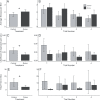Short-term exposure to unmanned aerial vehicles does not alter stress responses in breeding tree swallows
- PMID: 32864138
- PMCID: PMC7447841
- DOI: 10.1093/conphys/coaa080
Short-term exposure to unmanned aerial vehicles does not alter stress responses in breeding tree swallows
Abstract
Recent studies suggest that visual and acoustic anthropogenic disturbances can cause physiological stress in animals. Human-induced stress may be particularly problematic for birds as new technologies, such as drones, increasingly invade their low-altitude air space. Although professional and recreational drone usage is increasing rapidly, there is little information on how drones affect avian behavior and physiology. We examined the effects of drone activity on behavior and physiology in adult, box-nesting tree swallows (Tachycineta bicolor). Specifically, we monitored bird behavior during drone flights and in response to a control object and measured telomere lengths and corticosterone levels as indicators of longer-term physiological stress. We predicted that drone-exposed tree swallows would habituate behaviorally after multiple flights, but that telomeres would shorten more quickly and that baseline corticosterone levels would be altered. One significant and two strong, non-significant trends in behavioral assays indicated that adult swallows acted more aggressively towards drone presence compared to a control object, but were slower to approach the drone initially. Swallows were also more reluctant to use nest boxes during drone activity. Tree swallows habituated to drone presence as expected, although the rate of habituation often did not differ between drone-exposed and control groups. Contrary to our prediction, drone activity did not affect telomere length, corticosterone levels, body mass or fledging rates. Overall, our results indicate that a small number of short, targeted, drone flights do not impact tree swallow health or productivity differently than a non-invasive control object. Minor behavioral differences suggest that increasing the frequency of drone use could impact this species. We provide some of the first results addressing how drone activity alters behavioral, physiological and molecular responses to stress in songbirds. A better understanding of these impacts will allow ecologists to make more informed decisions on the use and regulation of new drone technologies.
Keywords: behavior; corticosterone; drone; stress; telomere; tree swallow.
© The Author(s) 2020. Published by Oxford University Press and the Society for Experimental Biology.
Figures



References
LinkOut - more resources
Full Text Sources

